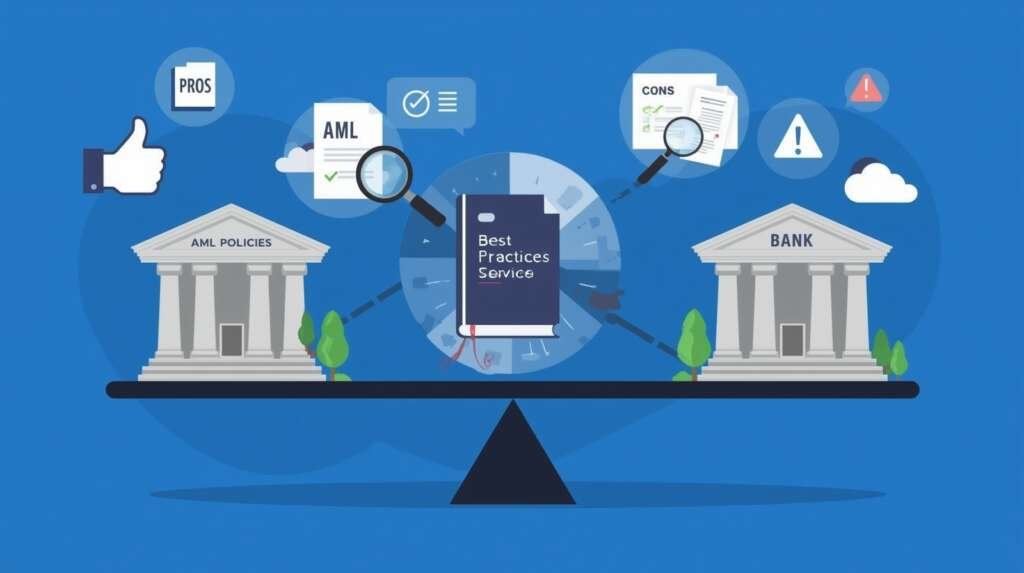Ever wondered what goes on behind the scenes at your bank or the crypto exchange you use? Beyond managing your money, there’s a huge, constant battle against some really bad actors. We’re talking about criminals trying to “wash” their dirty money – making it look legitimate – or worse, trying to fund terrorism.
This fight is called Anti-Money Laundering (AML) compliance. It’s basically a set of rules and systems designed to detect and stop illegal money from flowing through the financial world. Regulators around the world are watching closely, and here in the UAE, our financial watchdogs, like the Central Bank of the UAE (CBUAE) and the Virtual Assets Regulatory Authority (VARA) for crypto firms, are very serious about it. If companies don’t follow these rules, they face massive fines, their reputation gets trashed, and they could even lose their license to operate.
So, imagine you’re running one of these financial companies. You’ve got a crucial decision to make: Do you build your own massive “crime-fighting department” from scratch, hiring all the experts and buying all the fancy tech? Or do you get help from outside, partnering with a specialist company that does this kind of detective work for a living, often using super-smart Regulatory Technology “RegTech” solutions?
It’s not just a small business decision; it’s a multi-million-dollar question that affects how smoothly things run, how safe your customers’ money is, and ultimately, if you stay in business. Let’s break down this big dilemma, looking at the good parts, the tricky parts, and the smart moves for both options.
Option 1: Building Your Own AML Fortress
For a long time, especially for the really big banks, doing AML “in-house” was the only way. It meant hiring tons of people, from sharp-eyed analysts to tech gurus, and investing a fortune in specialized software and computer systems. It’s like building your own private security force and equipping them with everything they need, right inside your company’s walls.
Advantages of the In-House AML Model:
- Total Control, Your Way: A primary benefit of the in-house model is the absolute control an institution retains over its entire AML program. This allows for the meticulous design and customization of processes, policies, and controls that are precisely tailored to the organization’s unique business model, specific risk appetite, and the regulatory requirements of its operational jurisdictions. Any changes in product offerings, business processes, or regulatory directives can be immediately and directly translated into adaptations within the internal AML framework.
- Knowing Your Business Inside Out: Your internal AML team lives and breathes your company. They cultivates an intimate understanding of the organization’s specific customer demographics, product intricacies, operational workflows, and historical data patterns. Over time, they build up an incredible “gut feeling” for what’s normal and what’s suspicious for your specific business. This deep, built-in knowledge can be priceless for spotting tricky money laundering schemes that might slip past someone who’s not as intimately familiar with your world and crucial for highly effective risk assessment and detection.
- Enhanced Data Security and Direct Oversight: For organizations managing highly sensitive customer and transactional data, maintaining AML operations in-house offers superior control over data privacy and security protocols. All sensitive information remains within the organization’s direct technological and governance perimeter. This mitigates reliance on third-party data handling practices and provides greater assurance regarding the confidentiality and integrity of proprietary and customer data, particularly vital under strict global data protection regulations.
- Smooth, Seamless Teamwork: Imagine trying to coordinate a complicated project with someone outside your company versus someone in the next office. When your AML team is in-house, they’re part of the same company culture, use the same internal tools, and can literally walk over to the next department to get answers. This leads to much smoother communication, faster investigations, and a more unified approach to fighting financial crime across the entire organization.
- Quick Reactions to Problems: When a suspicious activity alert is generated, or a regulatory inquiry is initiated, an in-house team can facilitate direct and immediate communication with all relevant internal stakeholders. There are no external contracts to worry about, no different time zones, and no layers of bureaucracy. This speed can be crucial when dealing with fast-moving financial crime investigations or urgent regulatory demands.
Disadvantages of the In-House AML Model:
- Mind-Boggling Costs (and They Keep Coming!): This is often the deal-breaker. Building your own AML fortress is eye-wateringly expensive. You’re not just paying for staff salaries. Think huge investments in:
- High-End Software: Licenses can cost millions, and they need constant updates.
- Powerful Hardware: Servers, data storage, and the computers needed to run everything.
- Data Storage: Storing years of transaction data for millions of customers.
- Recruitment: Finding and hiring top AML talent is tough and expensive.
- Training: Keeping your team updated on the latest criminal tricks and regulatory changes.
- Ongoing Maintenance: Keeping all that complex tech running smoothly.For many companies, especially medium-sized ones or startups, these costs simply make the in-house dream impossible.
- Intense Competition for Specialized Talent and Retention Challenges: The global demand for highly skilled AML professionals—including certified compliance officers, financial crime investigators, data scientists proficient in risk analytics, and RegTech engineers—consistently outstrips supply. Consequently, attracting, recruiting, and retaining top talent in this specialized and highly competitive domain is both arduous and costly, frequently leading to high staff turnover, elevated recruitment expenses, and potential staffing deficiencies that can compromise compliance efficacy.
- The Unrelenting Pace of Regulatory Dynamics: AML regulations are characterized by their constant evolution, undergoing frequent, often rapid, and sometimes unpredictable changes across multiple international jurisdictions. Imagine trying to keep up with every new law, every new guideline, and every new criminal trick across the globe. An in-house team needs dedicated resources just to monitor these changes, understand what they mean, and then quickly update all your company’s policies and systems. It’s a full-time job for a specialized legal and compliance team, and it never stops.
- Scalability Limitations and Inflexibility: In-house AML systems and operational teams can exhibit inherent rigidities. What happens if your company suddenly grows really fast? Or you launch a hugely popular new product? Or you decide to expand into a new country with different rules? Your in-house AML system might not be ready for that sudden explosion of work. Scaling up an in-house team or system rapidly to accommodate new demands is typically time-consuming, highly expensive, and carries the risk of accumulating compliance backlogs or missing critical regulatory deadlines during periods of peak activity.
- The “Bubble” Effect: When you’re always looking inward, you might miss what’s happening outside. An in-house team, however brilliant, might inadvertently get stuck in its own ways, or become too familiar with internal quirks. This can potentially lead to the oversight of novel or subtle financial crime typologies that an external provider, benefiting from exposure to a diverse client base and various industry sectors, might more readily identify. There is also a risk of unconscious bias or reluctance to challenge ingrained operational practices.
Option 2: The “Smart Partner” Approach – Outsourcing with RegTech
Outsourcing AML compliance involves delegating some or all of an organization’s AML functions to a specialized external provider. This model frequently entails partnering with a “RegTech” firm—organizations that harness advanced technology to enable financial institutions to manage and comply with regulatory requirements with greater efficiency, precision, and agility.
Advantages of Outsourcing AML:
- Access to Specialized Expertise and Advanced Technology: Outsourced providers, especially RegTech specialists, possess a singular focus on AML compliance. They commit substantial, continuous investments in developing and deploying cutting-edge technologies, including Artificial Intelligence (AI), Machine Learning (ML), robotic process automation, and advanced data analytics platforms. These sophisticated tools may be prohibitively expensive or too technically complex for individual organizations to develop and maintain independently. Furthermore, these providers employ extensive, multidisciplinary teams of experts who are rigorously updated on the latest global and regional regulatory changes. This partnership grants organizations access to world-class tools and specialized knowledge without the onerous upfront capital expenditures.
- Significant Cost Reduction and Enhanced Operational Efficiency: While outsourcing entails ongoing service fees, it consistently yields substantial overall cost savings when compared to the high fixed and variable costs associated with operating a comprehensive in-house AML department. Organizations can reduce expenses related to recruitment, extensive compensation packages, employee benefits, infrastructure maintenance, software licensing, and continuous professional training. Automation facilitated by RegTech solutions rigorously streamlines compliance processes, reducing manual effort, minimizing human error, and enabling internal personnel to reallocate their focus to core business activities that drive strategic growth and innovation.
- Superior Scalability and Operational Flexibility: A paramount advantage of outsourcing, particularly to cloud-based RegTech solutions, is the inherent capacity for rapid scalability. Providers can seamlessly adjust their service capacity upwards or downwards based on fluctuating business demands, sudden surges in transaction volumes, or strategic expansion into new international markets and jurisdictions. This inherent agility is invaluable for businesses experiencing rapid growth, managing seasonal operational fluctuations, or exploring new geographic territories without incurring the substantial burden of rapidly recruiting or downsizing internal teams.
- Accelerated Implementation and Continuous Regulatory Adaptation: RegTech solutions are typically engineered for rapid deployment and integration, often being “off-the-shelf” or API-driven. This enables significantly faster setup times and expedited time-to-compliance, which is particularly advantageous for addressing urgent regulatory mandates or executing new market entry strategies. Moreover, reputable outsourced providers are contractually obligated and motivated to continuously update their systems to reflect the latest global and regional regulatory changes, ensuring the client’s compliance posture remains perpetually current without requiring constant internal development cycles.
- Enhanced Accuracy and Reduction of “False Positives”: The sophisticated analytical capabilities, including AI and machine learning, embedded within RegTech solutions can dramatically improve the accuracy of AML monitoring processes. This leads to a significant reduction in “false positives” (alerts that initially appear suspicious but are subsequently determined to be legitimate upon investigation). This increased efficiency frees up valuable human analyst time to concentrate on genuinely suspicious activities, resulting in more precise investigations, quicker case resolution, and optimized allocation of compliance resources.
- Improved Risk Management Posture and Enhanced Audit Readiness: External AML providers often implement a highly structured, proactive, and risk-based approach to compliance. They possess extensive experience in conducting thorough risk assessments, designing robust controls, and maintaining up-to-date policies that consistently meet and often exceed regulatory expectations. Their objective, external perspective can provide an additional layer of assurance, significantly enhancing an organization’s audit readiness and potentially reducing the likelihood of adverse regulatory enforcement actions.
Disadvantages of Outsourcing AML Compliance:
- Diminished Direct Control and Oversight: While the ultimate legal and regulatory responsibility for AML compliance remains with the regulated entity, outsourcing necessitates a delegation of direct operational control over daily processes. This demands the management of provider relationship, the establishment of rigorously defined service level agreements (SLAs), and robust internal oversight mechanisms to ensure continuous adherence to expectations.
- Inherent Data Security and Confidentiality Risks: The act of sharing sensitive customer and transactional data with a third-party introduces inherent data security and confidentiality risks. Organizations must conduct exhaustive due diligence on prospective providers’ security frameworks, data handling practices, and their adherence to all relevant global and local data protection regulations (e.g., GDPR, local data privacy laws). Comprehensive contractual agreements explicitly defining data ownership, usage rights, and robust security protocols are imperative.
- Potential Communication and Integration Complexities: Despite efforts to streamline communication, potential miscommunications or delays can arise if communication channels with the outsourced provider are not defined and consistently maintained. Furthermore, while RegTech aims for seamless integration, linking external cloud-based solutions with complex legacy internal IT systems can sometimes present significant technical challenges, necessitating dedicated internal IT resources and expertise.
- Risk of Internal Institutional Knowledge Erosion: Over extended periods, a substantial reliance on an external provider for specific AML functions may lead to a gradual reduction in internal institutional knowledge related to those tasks. This could become problematic if the organization later decides to insource the function, changes providers, or needs to respond swiftly to a highly specific, internally contextualized AML event. Maintaining a core internal team with oversight capabilities is critical.
- Standardization Versus Customization Trade-offs: Outsourced solutions often leverage standardized processes to achieve economies of scale and operational efficiency across multiple clients. While many RegTech providers offer configurable solutions, organizations with highly unique or exceptionally bespoke internal compliance workflows might find that a standard outsourced solution requires significant customization, potentially incurring additional costs or limiting the precise alignment.
Best Practices for Effective AML Outsourcing and RegTech Partnerships
When a company decides to outsource its Anti-Money Laundering (AML) compliance, it’s making a big strategic move. To make sure this partnership works effectively and avoids risks, there are several key best practices to follow. Think of these as essential guidelines for a successful collaboration that keeps your company safe and compliant.
Choosing Your Partner Wisely
First and foremost, thoroughly check out any potential service provider. Don’t just pick the first one; really dig into their background. This means looking closely at their expertise, their past work, any issues they’ve had with regulators, and their security systems. You should also check their financial health and how they plan to keep things running if there’s a disaster. It’s smart to ask for references from other clients and review their independent audit reports. This careful vetting helps you choose a reliable and secure partner.
Setting Clear Expectations from the Start
Next, it’s crucial to clearly define what everyone is responsible for. This isn’t just a handshake deal; it needs to be in a detailed, legally binding written agreement. This contract should precisely outline the exact services the provider will deliver, how you’ll measure their performance (using specific metrics called Service Level Agreements, or SLAs), what reports you’ll get, and who owns the data. It also needs to cover how data will be kept secure and private, your rights to audit their work, and what happens if the agreement needs to end. Leaving no room for confusion in this document is vital.
Keeping Control Even When Outsourcing
Even if you hand over some AML tasks, you must maintain strong internal oversight and accountability. Remember, your company always carries the final legal responsibility for AML compliance. This means you need a qualified person internally, like an AML Compliance Officer (AMLCO) or a Money Laundering Reporting Officer (MLRO). Their main job is to watch over the outsourced work, regularly check its quality against key performance indicators (KPIs), and make final decisions on crucial compliance matters, such as approving suspicious transaction reports.
Understanding New Risks from Outsourcing
Before signing any agreements, it’s important to assess the risks that come with the outsourcing arrangement itself. Take time to identify any potential money laundering or terrorism financing risks that might arise from this new setup. You need to be sure that the provider’s services are specifically designed to address your company’s unique risks, not just offer a generic solution that might not fit your exact needs.
Ensuring They Play by the Rules, Everywhere
It’s essential to confirm that the outsourced provider fully understands and can consistently meet all the specific AML/CFT rules in every country where you operate. They should be able to clearly show you how they stay updated on new regulations and how quickly they put those changes into action in their systems. This ensures your compliance stays current, no matter how fast regulations change.
Building Strong Communication Lines
For the partnership to work well, establish robust communication and collaboration channels. This means setting clear ways to talk, defining how urgent issues will be escalated, and scheduling regular meetings and reports. Building a proactive and cooperative relationship between your internal compliance team and the outsourced provider ensures that information flows smoothly and any emerging issues are resolved quickly.
Protecting Your Data: It’s Still Yours
Even if the provider handles your data, you must implement stringent data governance policies. Your company needs to maintain clear internal rules about who owns the data, who can access it, where it’s stored, and how it’s transferred. Ensure that strong data security measures are in place for both your company and the provider. It’s also critical to have a clear plan for how you can easily access and retrieve all your data if you ever need to switch providers or bring the work back in-house.
Continuous Monitoring and Review
Don’t just set up the outsourcing arrangement and forget about it. Adopt a proactive and continuous monitoring approach. Regularly check the provider’s performance against the agreed-upon SLAs. Also, conduct periodic, independent reviews and audits of the entire outsourcing setup. This ensures ongoing compliance, confirms that the services remain effective, and guarantees they continue to align with your evolving business needs and regulatory expectations.
Training Your Own Team
Finally, invest in training and awareness for your own employees. Make sure your internal staff, especially those who interact directly with the outsourced provider or whose roles touch on AML responsibilities, receive thorough training. They need to understand the new processes, communication rules, and their ongoing AML obligations within the new outsourcing framework. This ensures everyone plays their part in maintaining strong AML defenses.
A Decision for the Modern Financial Institution
The choice between maintaining an in-house AML function and strategically partnering with an outsourced RegTech specialist is a complex strategic decision. It is not a one-size-fits-all solution and is heavily contingent upon a multitude of factors unique to each organization:
- Organizational Scale and Complexity: Very large, multinational financial institutions with extensive resources and highly bespoke operational requirements may gravitate towards retaining greater in-house control. Conversely, smaller, rapidly expanding, or highly specialized entities (e.g., FinTech startups, pure-play digital asset firms, niche banks) frequently derive substantial benefits from the inherent scalability and specialized expertise offered by outsourced models.
- Budgetary Constraints and Resource Allocation Philosophy: Organizations must meticulously weigh the substantial upfront capital expenditure and fixed ongoing operational costs associated with an in-house department against the more predictable operational costs and potentially lower total cost of ownership inherent in outsourcing arrangements.
- Risk Appetite and Control Philosophy: The organization’s intrinsic comfort level with delegating direct operational control and its appetite for managing third-party risks play a significant role in this strategic choice.
- Regulatory Environment and Global Footprint: Firms operating across multiple, complex international jurisdictions characterized by diverse regulatory mandates may find a RegTech provider’s multi-jurisdictional compliance expertise, global intelligence, and adaptive technology to be an invaluable asset.
- Internal Expertise and Technological Maturity: A candid self-assessment of whether the organization possesses the requisite internal talent pool, technological infrastructure, and continuous development capabilities to build and sustain cutting-edge AML systems that can effectively keep pace with evolving threats and regulatory dynamics is crucial.
Ultimately, whether an organization elects to fortify its AML capabilities internally or strategically collaborate with an external specialist, the overarching objective remains immutable: to establish an impenetrable, adaptable, and highly effective defense against financial crime. In today’s dynamic, interconnected, and unforgiving regulatory landscape, the most prudent strategic choice is the one that most efficiently and effectively leverages the optimal blend of technology and human expertise to ensure not just compliance, but enduring financial security and resilience.




